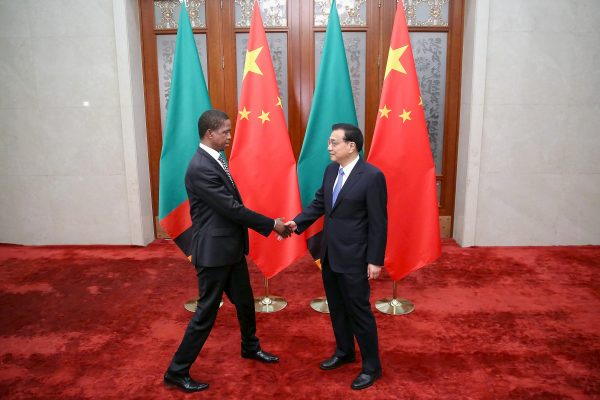On 2 November 2016, the China Civil Engineering Construction Corporation, a subsidiary of the state-owned China Railway Construction Corporation, signed a US$2.3 billion contract with the Ministry of Transport and Communications Zambia for the construction of the Zambia East Line. The line would run for 388 kilometres from Serenje on the Zambian Railways network to Petauke and Chipata, linking the railway networks of Zambia and Malawi.
Under the guidance of its 13th Five-Year Plan, China is vigorously promoting its international cooperation capacity and ‘going out’ strategy. Following the Belt and Road and Asian Infrastructure Investment Bank initiatives, China proposed a new strategy: international cooperation capacity. In May 2015, the State Council issued the ‘Guiding Opinions on Promoting International Production Cooperation and Equipment Manufacturing’, which describes China’s industrial development strategy for partner countries, laying out a plan for fiscal and taxation policy support, financial support and government services.
According to the National Development and Reform Commission, the layout of China’s international production cooperation as ‘an axis with two wings’ has quickly formed. Its key neighbouring countries act as a ‘spindle’ while Africa, the Middle East and key Central and Eastern European countries are the ‘West Wing’. Latin American countries form the ‘East Wing’.
China has listed Africa as one of its most important partners in its capacity cooperation initiative, and actively encouraged and guided its state-owned enterprises (SOEs) to invest as part of China’s Africa strategy. Zambia is of primary importance, with the copper industry the key investment target. In 2016, Chinese investment in Zambia grew by US$295 million, ranking first among African economies.
China is presently Zambia’s second largest trading partner as well as the country’s main source of foreign investment. Over the past two decades a mining SOE, China Non-Ferrous Metal Mining Group Company (CNMC), has been exploring Chambishi copper mine in Zambia’s Copperbelt, largely through the subsidiary Non-Ferrous China Africa.
Zambia is Africa’s second, and the world’s seventh, largest copper producer, with copper production totalling 740,000 metric tons in 2016. Before independence, Zambia had established an industrial cluster of copper and related industries, and copper exports were the sole pillar industry for international capital. Post independence, with the withdrawal of British capital, the copper industry experienced a prolonged recession and effective collapse under neoliberal privatisation in the 1980s and 90s.
The mining projects built and put into production by CNMC include Chambishi Copper Mine, a 150,000-ton copper smelter and Chambishi Leach Plant. The Zambian government had been trying to mimic the effects of East Asian export-oriented manufacturing Special Economic Zones (EZs) since the 1990s. Since then, the copper mining sector has become the backbone of Zambia’s economy. By the end of 2015, China was the second-largest destination for Zambian copper exports.
In 2007, CNMC built the Zambia–China Economic and Trade Cooperation Zone (ZCCZ) in Chambishi and east Lusaka, which is the first Chinese built multi-facility economic and trade co-operation zone in Africa. By the end of 2015, the ZCCZ had attracted around 50 investors with total investment of over US$1.5 billion to drive the country’s industrialisation, job creation, and wider economic development.
But Chinese FDI is facing widespread opposition. The failure of Zambia’s industrial development to deliver benefits for Zambian people has resulted in resource nationalism and anti-Chinese sentiments that have mushroomed since 2005.
Although populist rhetoric is directed against control of the Zambian economy by foreign investors in general, China has become the sole scapegoat for foreign capital’s exploitation of Zambian copper — the centrepiece of Zambia’s economy and international identity. Chinese SOEs are seen by Zambians as agents of a foreign sovereign state exploiting Zambian national resources, not simply as private capital investment. This sentiment was exploited by populist political parties amid demands from Zambian elites for more direct benefits from mining revenues.
Sino–African geopolitics are now subordinate to China’s geo-economic goals. China’s approach to Africa is narrowly economic and defined by two principal goals: to open new import markets as China becomes a net-importer, and to acquire whole value chains from resource commodities to final product. Most of the large recipients of Chinese FDI are countries with mineral wealth: South Africa, Kenya, Sudan, Mozambique, Angola, Zambia, Nigeria and Ethiopia.
Looking ahead, the challenge for China’s geo-economic policy in Africa will be to balance a globalisation 2.0 agenda, bringing fixed-capital investment projects while developing a greater level of local government partnerships. Institutional integration as well as capital integration are needed if China’s Africa policy is to truly deliver development solutions to Zambia.
Celine Wang is a research intern at the Public Policy Research Centre, Almaty, Kazakhstan.

